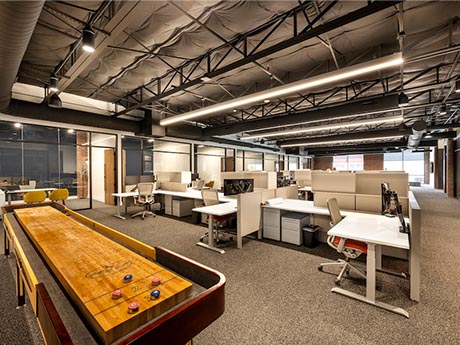By Wes Snow, co-founder and CEO, Ascendix Technologies
For the first time since the COVID-19 pandemic began, offices are 50 percent occupied nationally as companies push harder for returns to their buildings — which is good news. Still, amid this encouraging development, inflation, interest rate hikes and general fears of recession might impede businesses planning to align their office rent expenses with the pre-pandemic rates.
Can businesses optimize the space they’re already utilizing without renting more? At Ascendix Technologies, a company that has been specializing in custom real estate software development for two decades, we’ve seen a variety of space extension practices applied by office owners and managers. Here are some methods that users can employ too maximize efficiency within their existing footprints.

Implement Open Floor Plans
Not only do wall-less spaces encourage collaboration among teams and reduce the need for spacious individual offices, they also increase flexibility in terms of how space is utilized. Reconfiguring spaces is easy with movable walls and modular furniture and represents an option that helps growing businesses align their changing needs with the spaces they’ve got.
Upgrading open-floor space management with automation is another viable option. With a technology like floor management software or computer-aided design tools (CAD), office users can get panoramic views of their spaces and reconfigure the elements like furniture in the virtual playground. Tenants can then implement the design ideas in reality.
Introduce Multi-Functional Spaces
Sometimes, allocating multiple purposes to the same space is enough to increase office efficiency, especially for smaller businesses. As an example, using modular furniture to reshape a break room into a conference room when required will spare you from renting more space.
To prevent scheduling conflicts, teams can use real-time information about room availability and reserve space with desk and room booking or facility management software. In fact, any digital solution with scheduling functionality, user-friendly design and team access will do the job. Just make sure the option includes 2-D and 3-D features so employees can see the allocation of furniture and equipment in the scheme, room dimensions and the placement of elements like doors and windows.
Track Space Usage with Smart Devices
Sensor technologies can be used for tracking occupancy and traffic rates, helping tenants get a full picture of how space is used. Coupled with building management systems, sensor tools and similar devices assist users in monitoring and collecting data on temperature, humidity, noise and lighting.
With ample data at their fingertips, office users can make smarter space planning decisions. For instance, by monitoring occupancy, tenants know which spaces are under- or over-utilized and adjust the quantity of office equipment in a way that matches the occupancy rates. Meanwhile, identifying the highest-traffic areas will help tenants decide whether they need to remodel such spaces with wider halls or introduce open floors to improve flow.
Leverage Hybrid Workstyles
In the age of teleworking and digital nomadism, less physical space is required to accommodate employees under the same roof. And with office attendance being lower during the post-pandemic period, companies need less office equipment, resulting in less wear and tear. In addition, having fewer in-person meetings implies that spaces like conference rooms can be used as collaboration or quiet areas on occasion.
Learning more about the nature of your employees’ work routines and their preferred combination of “remote” versus “in-office” is also key to optimizing efficient use of space. Gather feedback from employees and introduce workspace practices like hot desking — when employees aren’t assigned workstations but instead use desks that are available at the moment — to cut back on equipment expenses and the square footage cluttered by additional workstations.
Lastly, tenants can leverage desk and room booking software to create consistent hybrid experiences and reduce no-shows. With such software, your employees can book office spaces from home, thereby avoiding double bookings and getting automated reminders.
Eliminate Physical Storage Space
Instead of letting multiple folders pile up in filing cabinets and boxes, declutter your premises by embracing space-saving technologies like external hard drives, USB flash drives and others.
Focusing solely on cloud storage practices to fully reduce the need for physical storage hardware is another effective tactic in maximizing efficiency. The best helpers in this case are document or digital asset management systems and reporting tools. Such solutions allow users to digitize documents and store and manage them on the cloud — a great way to centralize data and reduce costs without purchasing more storage furniture.
Manage Office Inventory
Having full transparency on inventory needs helps tenants find out which items can be reduced to free up more space. Tracking the use of the office equipment — by who and how often it’s used — with IoT sensors and subsequently analyzing the results withIoT analytics platforms can accomplish this goal. For instance, some workstations might have higher-than-average downtimes; reducing their number will be a cost-saving decision.
Other than that, tenants can use cloud-based inventory management systems to get up-to-the-minute insights on inventory levels to prevent understocking or excess.
When it comes to space planning, companies can operate within the budget and square footage they already have instead of renting more. Melding the traditional practices and technologies according to individual company traits and needs can help offices users rethink the functionality of their spaces, increase their utilization and boost employee productivity without losing a dime.
— Based in Dallas, Ascendix Technologies provides customer relationship management software for the commercial real estate industry.


